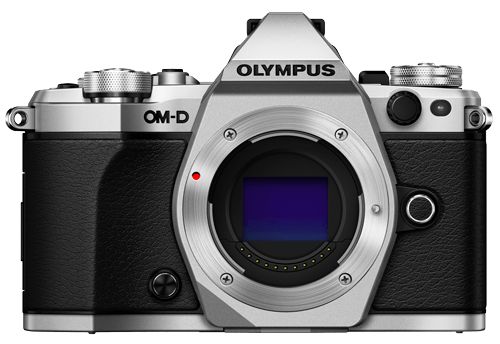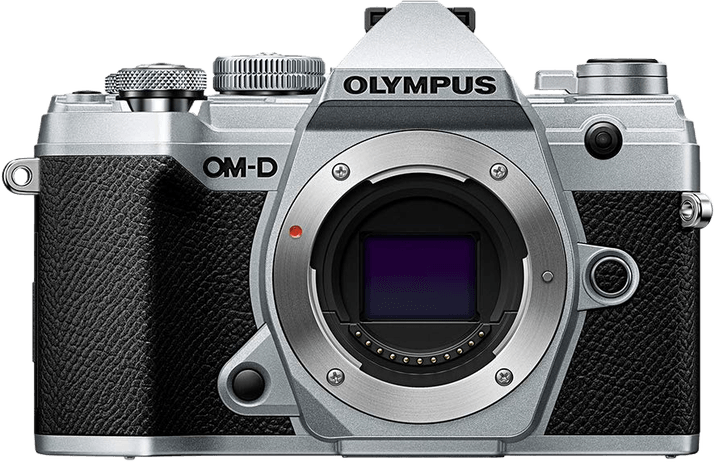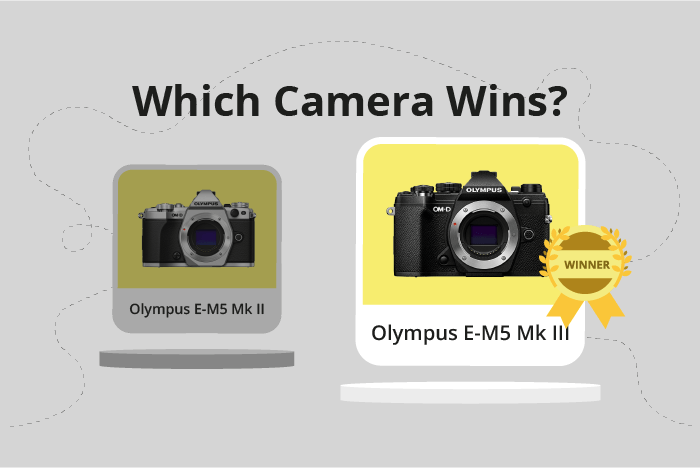Olympus OM-D E-M5 Mark II vs OM-D E-M5 Mark III Comparison
Olympus OM-D E-M5 Mark II

Olympus OM-D E-M5 Mark III

The Olympus OM-D E-M5 Mark III emerges as the winner with a score of 65/100, while its predecessor, the Olympus OM-D E-M5 Mark II, scores 59/100. Both cameras are mirrorless and share similar dimensions, with the Mark III being slightly larger at 125 x 85 x 50mm compared to the Mark II’s 124 x 85 x 45mm.
The Mark III outshines the Mark II with its lighter weight of 414g, making it more convenient for photographers. Additionally, it was released in 2019, making it a more recent model with updated features. However, the Mark II has its advantages, such as a lower launch price of $1100 compared to the Mark III’s $1199.
Taking these factors into account, the Olympus OM-D E-M5 Mark III is a better camera due to its higher score, lighter weight, and updated features. The Mark II may still appeal to budget-conscious photographers.
Olympus OM-D E-M5 Mark II vs OM-D E-M5 Mark III Overview and Optics
The Olympus OM-D E-M5 Mark III wins the optics comparison with a score of 60/100, while the Olympus OM-D E-M5 Mark II scores 58/100. Both cameras share several optical specifications, such as having a CMOS sensor, a Micro Four Thirds sensor size, a Micro 4/3 lens mount, and image stabilization.
The Mark III outperforms the Mark II in several aspects. It has a higher megapixel count (20 vs. 16.1), allowing for more detailed images. The Mark III also boasts a faster shooting speed (30 vs. 10), enabling users to capture fast-moving subjects more effectively. Additionally, the Mark III features an improved processor, the TruePic VIII, compared to the Mark II’s TruePic VII, which results in better image processing and overall performance.
However, the Mark II has a higher DXOMARK score for the sensor (73 vs. 55), indicating that it may produce better image quality in certain situations. This advantage is not enough to outweigh the benefits of the Mark III, but it is still a noteworthy aspect of the Mark II.
Considering these points, the Olympus OM-D E-M5 Mark III stands out as the better option for optics due to its higher megapixel count, faster shooting speed, and improved processor. The Mark II’s higher DXOMARK sensor score is worth noting, but it does not make up for the other advantages of the Mark III. Ultimately, photographers seeking better optical performance should opt for the Olympus OM-D E-M5 Mark III.
Olympus OM-D E-M5 Mark II vs OM-D E-M5 Mark III Video Performance
The Olympus OM-D E-M5 Mark III outperforms its predecessor, the OM-D E-M5 Mark II, in video capabilities with a score of 91/100, a significant 21-point lead over the Mark II’s 70/100. Both cameras share some common video features, such as built-in time-lapse functionality. However, the Mark III surpasses the Mark II in several aspects.
The Mark III boasts a maximum video resolution of 4K, while the Mark II only offers Full HD. This higher resolution in the Mark III results in sharper and more detailed footage, making it a better choice for videographers seeking top-quality videos. Additionally, the Mark III’s maximum video dimensions are 4096 x 2160, compared to the Mark II’s 1920 x 1080, further enhancing the visual quality.
Another advantage of the Mark III is its higher maximum video frame rate. It can achieve 120fps, whereas the Mark II is limited to 60fps. This difference allows the Mark III to produce smoother slow-motion videos, providing more creative options for users.
Despite its lower score, the Mark II still has some merits. Its Full HD resolution and 60fps frame rate are sufficient for everyday video recording and casual use. However, it falls short when compared to the Mark III’s advanced video features.
Taking all these factors into account, the Olympus OM-D E-M5 Mark III clearly excels in video capabilities. The Mark II may be suitable for casual users, but for those seeking higher quality and more creative options, the Mark III is the superior choice.
Olympus OM-D E-M5 Mark II vs OM-D E-M5 Mark III Features and Benefits
The Olympus OM-D E-M5 Mark III emerges as the winner with a feature score of 83/100, outperforming the Olympus OM-D E-M5 Mark II, which scores 70/100. Both cameras share several specifications, such as a 3-inch screen size, touchscreen capability, flip screen, absence of GPS, and WIFI connectivity.
The E-M5 Mark III’s superiority lies in its higher screen resolution of 1,040,000 dots, compared to the E-M5 Mark II’s 1,037,000 dots. This difference provides a slightly better image viewing experience. Additionally, the E-M5 Mark III includes Bluetooth connectivity, a feature absent in the E-M5 Mark II. This addition allows for seamless pairing with compatible devices and enhances the camera’s overall usability.
On the other hand, the E-M5 Mark II does not surpass the E-M5 Mark III in any specific feature. Both cameras share many similarities, but the Mark III’s improved screen resolution and Bluetooth connectivity give it an edge over its predecessor.
Considering these points, the Olympus OM-D E-M5 Mark III proves to be a better choice for photographers seeking enhanced features and connectivity. Its higher feature score reflects its superior specifications, making it a more appealing option for users. While the E-M5 Mark II remains a reliable camera, the E-M5 Mark III stands out with its additional offerings and improved viewing experience.
Olympus OM-D E-M5 Mark II vs OM-D E-M5 Mark III Storage and Battery
The Olympus OM-D E-M5 Mark III wins in the storage and battery category with a score of 35/100, while the Olympus OM-D E-M5 Mark II scores 21/100. Both cameras share similarities in storage and battery specifications. They each have one memory card slot and support SD, SDHC, and SDXC memory cards.
The Mark III outperforms the Mark II in two aspects. Firstly, it is UHS-II compatible, allowing for faster data transfer and overall better performance. Secondly, the Mark III offers USB charging, providing more convenience and flexibility in charging the camera’s battery.
On the other hand, the Mark II does not have any advantages over the Mark III in terms of storage and battery. Both cameras have the same battery life of 310 shots, and the only difference between their battery types is the model number.
Taking these factors into account, the Olympus OM-D E-M5 Mark III proves to be the superior choice for storage and battery capabilities, offering faster memory card performance and the convenience of USB charging. The Olympus OM-D E-M5 Mark II does not provide any advantages in this category, making the Mark III the clear winner.
Olympus OM-D E-M5 Mark II vs OM-D E-M5 Mark III – Our Verdict
Are you still undecided about which camera is right for you? Have a look at these popular comparisons that feature the Olympus OM-D E-M5 Mark II or the Olympus OM-D E-M5 Mark III:

